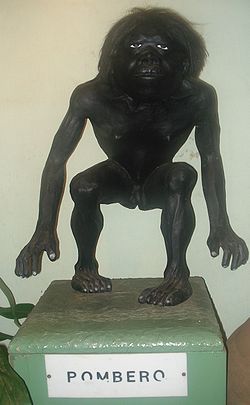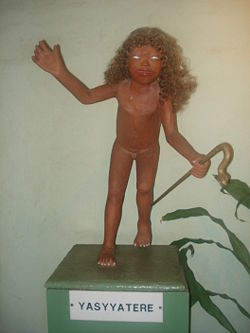- Mythical Museum Ramón Elías
-
The museum “Ramón Elías”, called honoring its founder, is located in Capiatá, Paraguay, going Route II “José Félix Estigarribia”19 km. far from Asunción, which is the capital city.
This museum evokes memories from Paraguay ancestors and at the same time is a calling out to maintain in the Paraguayan culture the magic presence of myths.
Contents
The founder
Ramón Elías was born November 10, 1929. His father was Don José Elías (Arabian) and his mother was Doña Francisca Fernández (Paraguayan).
His Elementary School was in Concepción, city in the North of Paraguay and Secondary in the capital city Asunción.
During childhood, he was interested in sports, especially basketball, he promoted basket in Capiatá and was also one of most popular player in Capiatà League.
On September 25, 1954, he married Elsa Agueda, Salvador Céspedes Valdez and Petrona Gamarra Gaona's daughter. They had six children: Felipe, Melva, Oscar Ramón, Elva Mercedes, Felipe Segundo and Elsa Concepción.
He was very good at painting so was given a scholarship at Escuela de Bellas Artes from Asunción. He also restored antiquities, through researches and recompilations, one of his favorite activities. He was very skillful and showed very special love to his work. From 1967 to 1972 he was a teacher (drawing and geometry) at Colegio Nacional de Capiatá, he also made the seal office of the Municipalidad.
Ramón Elías made native masks combining different kinds of ingredients, which are very beautiful, charming and admired by tourists. His masks were put on view at the Dirección de Turismo in Paraguay on May 1966 and La Casa Paraguaya in Buenos Aires, Argentina.
Since he was a very curious person and had a researcher spirit, he traveled all the small towns called the interior of the country looking for antiquities which were bought and restored to be sold. During that time he met many elderly people, who knew a lot of historic memories about tales of magic characters. That was the time when he got into the world of mystery about myths and dedicated himself to interpret and make people know through fantastic sculptures. Don Ramón Elías is considered the father of the images of Paraguayan myths the same that long ago were found only in Paraguayan literature.
The Beginning of the Museum
Elías´ interest and passion for the characters of the Paraguayan mythology was just amazing. Every single day was special for his research, data collection and visits to different places to gather information and small pieces of the Paraguayan history.
Ramón Elías had the idea of a place to put together all the objects he found from long ago, objects from the Guaraníes, Franciscanos, Jesuítas and from the Colonial period.
The “Mythical Museum Ramón Elías” opened in 1979.
Characteristics of the Museum
Going on Route II “Mariscal José Félix Estigarribia”, 19 kilometers from Asunción on the right you will see heavy and big gates to enter the museum; it has long and wide corridors and a beautiful garden too. Pottery from long ago can be seen in these corridors and also native carved doors in the entrance.
Getting into this wonderful place is to establish contact with the mystery of the objects which belonged to people from long ago. The lighting of this place, the walls, and the floor everything is the framework to be part of the magic monsters represented.
The museum has three big rooms: in the first room you can find all the creatures of the Paraguayan mythology; in the second one, all the objects and altarpieces from the first Franciscanos and Jesuitas who came to Paraguay to share their religion and believes. In the third room, photographs and elements used during the Triple Alianza war and the Chaco war.
Guaraní Mythology
Main article: Guarani mythologyAll the mythological creatures of the Paraguayan Culture are represented in the museum. Each one has its own story mixed up with what people believe it happened, a bit of real and fantasy. Explanations of those mysteries mind can not solve but the ancestors made them part of Paraguayan literature.
Inside glass boxes, human size the most popular characters of the Guaraní Mythology. They are Tau and Keraná, Ao Ao, Jasy Jateré, Pombero, Kuarahy Ra’y, Paje, Mala Visión, Luison, Mboi Jagua, Jagua Ru, Kurupi, Moñái, Mbói Tu'ĩ, Teju Jagua and Plata Yvyguy.Benefits for the Culture
The “Mythical Museum Ramón Elías” is important because it is a place where Paraguayan people find and transmit their culture and identity. Elías has worked a lot to give the portrait of time and characters that are part of the Paraguayan History. He worked with native people learning about facts from long ago and explaining the way Paraguayan people are, think and live.
Ramón Elías and his death
Elías worked during 20 years to show Paraguayan Culture, restoring images and objects from the past. He was traveling with his wife to Encarnación, a city south of Paraguay on February 28, 1981, they wanted to present the mythological images in curved wood during the carnival. But he died in a car accident on their way in San Luis.
In that place, as the Paraguayan Tradition states, there is a beauty and solemn cross made of bronze and big chains made of iron and pillars. It states: “Ramón Elías 1929–1981”.
Doña Elsa de Elías, his wife continued working on his project: The Museo Mitológico, which was built with a lot of sacrifice and dedication. He could only enjoy the museum for a short time: a year and some months.
References
External links
Categories:- Guaraní mythology
- Museums in Paraguay
Wikimedia Foundation. 2010.





